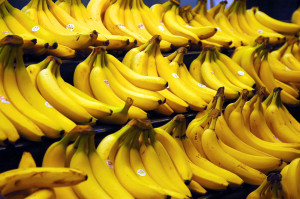The Radioactive Superfood: Bananas!
One of the most amazing fruits you’ve probably dismissed as ordinary is actually not a fruit, or ordinary.
The banana “tree” is actually the pseudostem of an herbaceous flowering plant that can grow up to 25 feet tall. This means that technically the banana that we eat is the “berry” of the largest herb on the planet!
The banana that we commonly refer to as a banana is actually only one of two varieties sold in grocery stores. In reality there are thousands of varieties of banana, but none are suitable for commercial use because they are starchy and bitter tasting.
The sweet banana that we enjoy today, the Cavendish banana, has only been cultivated for about 50 years and tastes nothing like its predecessor, the Gros Michel.
Bananas are all clones of one another and exhibit no genetic diversity. This leaves them susceptible to disease. In 1950, the Panama fungus destroyed all the Gros Michel bananas worldwide. The new Cavendish banana is also in jeopardy of disease and it’s estimated that in 10-20 years the banana as we know it may not be viable for agricultural use. This is astounding when you learn that the banana is the fourth largest agricultural product in the world with over 100 billion bananas consumed worldwide annually, following wheat, rice, and corn.
And now, some facts to impress your friends:
- You can ripen a banana by placing it in a paper bag with an apple overnight. This is because apples release ethylene gas, which causes bananas and other fruit to ripen quickly. Grocery stores buy green bananas and put them in rooms with artificial ethylene gas to ripen them before putting them on shelves.
- Bananas are naturally slightly radioactive! They contain the isotope potassium-40 which is radioactive. Proponents of nuclear power sometimes refer to the “banana equivalent dose” of radiation to support their arguments.
- Banana peel has the capability to extract heavy metal contamination from water.
- Banana shoots are processed by hand in Japanese culture to make soft, fine threads that are then dyed and woven to make traditional kimonos.
- Banana leaves are large, flexible, and waterproof. This allows them to be used to make plates and cups in asian cultures.
Comments
Tags: banana berry, banana facts, banana fruit, banana herb, banana uses, cavendish banana, ethylene gas, gros michel, radioactive bananas, ripen bananas
Trackback from your site.

